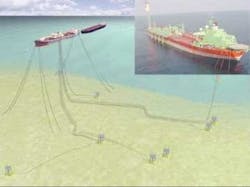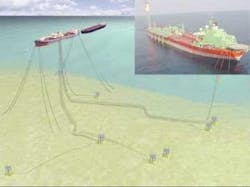Addax uses fit-for-purpose technology, simplified layout to develop Okwori
Ted Moon
Technology Editor
Addax Petroleum used a phased development plan and specifically selected technology to develop the challenging Okwori field offshore Nigeria. Okwori, located in the southern part of OPL-90, 90 km south of Port Harcourt, presented significant technological issues.
Although the field exhibits favorable oil properties, subsurface difficulties arise from the formation being made up of loosely held, very permeable sands and the fact that the reservoir is composed of numerous stacked oil pools and compartments. The oil columns vary from 5-350 ft.
The stacked nature of the oil-bearing sands and high degree of compartmentalization required production from different fault-dip closures to be commingled to make the development commercially viable.
Addax acquired the Okwori oil field assets from Ashland in 1998, after several previous operators passed on developing the field and commissioned its own 3D seismic study. To develop the estimated 40 MMbbl of reserves, Addax investigated several scenarios, eventually settling on a phased scheme that maximizes recoverable reserves and eliminates flaring of associated gas.
Their plan involved the sequential drilling of eight deviated wells using subsea wellheads, flexible flowlines, all hydraulic umbilicals, and dynamic risers connected to theSendje BergeFPSO, a converted and spread-moored vessel. The FPSO has oil storage capacity of 1.4 MMbbl and can process up to 60,000 b/d of liquids for an oil output of 38,000 b/d and gas compressing capacity of 55 MMcf/d. The FPSO was delivered to the field in late January, with a lease length for an initial four-year period. Capital costs are estimated at $230 million.
Management of produced gas was integrated in the project design at the outset, with studies indicating gas reinjection was not advisable due to the potential of rupturing fault-seals at depth with subsequent gas migration along major planes toward the seabed. Other gas disposal possibilities included shipping the gas through an export subsea pipeline to a third-party treatment facility or generating electricity on-board the FPSO and transmitting current onshore for domestic consumption via subsea electric cable.
In terms of drilling economics, batch drilling was selected, with each pair of producing wells surface-located within the range of the drilling rig chains to minimize the number of rig moves. Well sequencing was designed such that the rig was drilling the northernmost wells at the same time that reel lay and DSV vessels were laying flexible flowlines and umbilicals between the subsea wellheads and the FPSO.
New technology
Addax implemented several technology improvements and team dynamics to develop Okwori. The company placed great emphasis on aggressive and active project management, made up of both Nigerian nationals and international professionals with expertise in each phase of the project, from drilling and completion to reservoir engineering to geophysics and subsea systems. In addition, the international staff provided invaluable on-the-job training and knowledge transfer to the local professionals, which is part of Addax’s commitment to strengthen its local infrastructure. Overseeing the team was the Okwori project manager, who ensured that project goals and subsurface constraints remained aligned.
Addax implemented technological solutions to address challenges with sand control and production from stacked reservoir pools. To avoid the need for gravel packing techniques for sand control in the loosely aggregated reservoir, Addax implemented expandable sand screens that were inserted into the downhole assembly.
To produce several levels of the stacked oil pools in series, Addax employed selective hydraulically remote operated sliding sleeves (ROSS) as the appropriate reservoir control tool. Up to four ROSS’s have been successfully installed and operated in a single wellbore. This is one of the first subsea developments using this latest selective technology.
To successfully allocate production per reservoir when commingling, Okwori crudes were blueprinted using geochemical fingerprinting techniques. The crudes were also subjected to blind tests via private independent laboratories which specialize in geochemical fingerprinting.
The decision to use fit-for-purpose technology and keep the field layout simple has resulted in both cost and time savings. For example, the decision to proceed with subsea wells and flowlines versus surface wellheads came after detailed economic modeling. With the cost of steel rising, subsea development was determined to be more attractive than a platform in terms of upfront capex costs (subsea design may result in a factor of 10-20 lower cost structure versus building a platform).
In addition, subsea development allowed the operator to maintain opex costs at the established value of $4/bbl. As other satellites are appraised and tied back to the FPSO, opex is expected to stay in the $4/bbl range.
In terms of time savings, the aggressive and multifaceted project team and the implementation of technology such as ROSS and expandable sand screens made it possible for Addax to produce first oil 15 months after the investment decision was made, and only eight months after spudding the first development well.•
null


